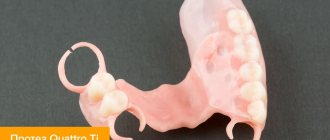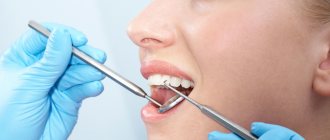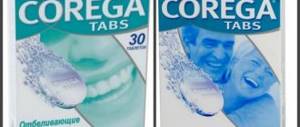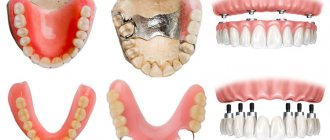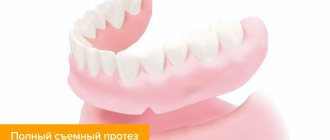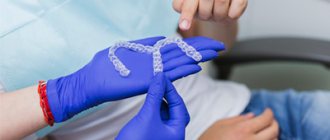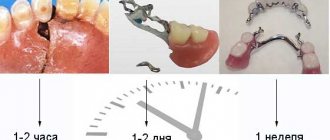Long-term absence of teeth in the sockets leads to impaired blood circulation and damage to the patient’s jaw bone tissue. There are several ways to restore teeth with severe edentia. One of the most popular methods is the installation of a covering prosthesis. What is he? This is a special design that is installed with support on implants or on the roots of the patient’s remaining dental units.
The popularity of such prosthetics is largely due to ease of use and high aesthetic qualities. Such designs are popularly called “false jaws.” They are placed on any jaw (upper or lower).
What is the difference between an overdenture and a removable denture?
Today, covering structures are quite popular. Many people have a question: what is better: a removable or a covering prosthesis?
Compared to a complete removable one, the covering design minimizes horizontal loads harmful to the remaining supporting teeth and significantly extends their life. In addition, this method allows you to stop the occurrence of atrophy processes in the maxillofacial region and reduces pressure on the mucous membrane.
Such systems have a lot of different devices: elastic clamps, attachments, magnetic and other structures, thanks to which the dentures are securely fixed and do not move either during chewing or at rest.
The main components of a dental overdenture are the telescopic system and the designs of the primary attachments. The attachment consists of 2 parts - the patrix (inner part) and the matrix (external part). The most complex part is usually fixed into a removable prosthesis, which makes it possible to replace it without adjusting the entire system. Root attachments significantly increase the functionality of the structure and also prevent atrophic processes in the alveolar processes. The highest quality dentures are those that have at least 3 locks. But with limited financial resources, 2 locks are successfully used.
Depending on the medical prescription and the expected effect, magnetic clamps are also used.
Clasps are used - metal hooks that fasten the tooth in the neck area, but when worn, the hooks are quite noticeable.
In some cases, for strength, dentures can be reinforced with a metal mesh or clasp frame.
Types of cable-stayed tires
Cable-stayed tires come in single-row and double-row.
- Single row.
Used for splinting areas with expected moderate chewing load, for example on the lower front teeth. They are also suitable for all cases of mobility of 1-2 degrees.
The most popular single-row pattern is the “figure eight”. For splinting, a thread is used that covers each tooth in a row alternately from the oral and vestibular sides. The threads intersect in the interdental spaces and form figure eights, and each tooth is covered from the oral and vestibular sides. By grasping and twisting the free ends, sufficient thread tension is ensured.
- Double row.
They are used in cases of presumably high destructive stresses, for example, for the upper front teeth, with mobility of 2-3 degrees, in the presence of end defects.
For double-row splinting, two threads are required. They can be used in the form of two parallel rows of figure eights. For anterior teeth, it is advisable to use a “hidden” two-row scheme. The first row in the cervical region is made in the shape of a figure eight, and the second is laid along the groove in the oral surface in the area of the cutting edge (indentation is at least 1 mm).
Indications for installation
- Presence of single roots in the oral cavity. In this case, the roots of the tooth bear the entire functional load.
- Edentia (complete absence of teeth) - in this case, the structure is installed on implants.
- Complete edentia of the lower jaw, since it is precisely on it that complete removable dentures do not adhere well.
Most often, covering prostheses are used in the following cases:
- complete absence of teeth or insufficient number of them;
- tooth crown fracture;
- severe abrasion of hard tissues;
- when the crown part of the tooth needs to be amputated.
- diseases of the cardiovascular system;
- blood clotting disorders (coagulation);
- diabetes;
- pathologies of the nervous system.
Covering dentures and their types
Covering dentures are classified into several types. Depending on the method of fastening, there are:
- Partial. Installed when several teeth are missing. Presented in the form of a structure that partially covers part of the gums. They are attached using clasps or on implants, which are implanted in places where teeth are missing.
- Full. They are used in cases of complete absence of teeth or their crown parts. The installation of such dentures is performed on implant pins or those that are screwed into the end part of their teeth. Systems with All-on-four implants are most often used.
Prosthetic covering structures can be made from different materials:
- acrylic – characterized by durability, aesthetics, and low cost;
- nylon – due to the softness and plasticity of the material, they do not cause the sensation of a foreign object in the oral cavity;
- acron - least traumatic for the gums and mucous membranes of the oral cavity;
- metal - the most durable, but not aesthetically pleasing enough, so they are often installed for chewing teeth.
The covering prosthesis can have different types of fastenings. For example, if it is installed on the root of a tooth, it requires grinding and setting with a special crown with a tip that snaps into the recess of the orthodontic structure. If placed on implants, fastening is performed using attachments; metal beams can also be used, which are located in the recess of the base. Upper dentures are attached to the roof of the mouth, but other options may be used. The iOrtho clinic will select the most suitable one.
Stages
Before carrying out covering prosthetics, special preparation of the soft tissues of the oral cavity is necessary - periodontal pockets or parts of the mucous membrane are removed.
Stages of installation of a covering prosthesis:
- After a preliminary examination and sanitation of the oral cavity, impressions are taken from the lower and upper jaws with an alginate mass.
- Diagnostic models are made from durable plaster, on which the central occlusion and jaw relationship are determined.
- The dentist, together with the dental technician, analyzes diagnostic models and selects the design of the overdenture. If necessary, parallelometry of the alveolar ridge and teeth is performed.
- A temporary bare denture is made for use during the manufacture of a permanent one.
- The procedure for preparing abutment teeth is carried out in the dental office.
- Using silicone material, an impression of the jaws and prepared supporting teeth is taken.
- Based on the impression obtained, the dental technician creates a collapsible working model.
- The prepared wax composition is cast and then fitted onto the model.
- In the clinic, primary dental crowns are fitted on the supporting teeth.
- The dental technician creates a new model, which clearly shows the edges of the future covering prosthesis. Primary crowns are milled with carbide cutters and polished with fine diamond paste.
- A new working model is being prepared for duplication. A fireproof model is created from a special mass, on which a wax frame of the prosthesis is formed, and then cast.
- The cast frame is attached to the primary crowns, the outer telescopic crowns are polished from the inside with fine diamond paste, and the entire system is prepared for electric spark erosion.
- Electric spark erosion is performed using special equipment.
- The working model is placed in a spark erosion apparatus. After that, the dental technician fits the selected friction pins into the formed grooves and fixes them by contact welding.
- The clinic performs fitting of secondary crowns and removable denture frames.
- In the laboratory, secondary telescopic crowns are veneered, and the wax base is replaced with a plastic one.
- After installing the prosthesis, the occlusion is corrected and the primary crowns are fixed one by one with cement.
Laying and tensioning the thread
The thread should not be over-tightened, otherwise pathological displacement of the teeth may occur. To avoid this, the thread is pulled after laying in the grooves, and its ends are twisted together. The tension of the thread can always lead to displacement of mobile teeth, regardless of the splinting scheme. Therefore, after manipulation, verification and occlusion are mandatory.
The interdental spaces with the nodes located in them are etched with acid, then treated with an adhesive substance and filled with a composite of fluid consistency, and the ends of the threads are cut off. Splintcord threads, available in two sizes and four colors, are most suitable for cable-stayed splinting.
BPS technology
The BPS system optimizes the process of creating overdentures, making them more reliable and durable. System Features:
- cutting-edge material reduces abrasion of implant-supported prostheses;
- wide choice of shapes;
- combination of layers;
- color fastness;
- the color scheme corresponds to fixed dentures;
- unhindered movements when chewing;
- resistance to plaque;
- good fissure-tubercle ratio.
Overdenture according to the BPS system
BPS dentures are a state-of-the-art product resulting from a combination of high-quality materials and close collaboration between dental technicians and dentists.
Stump inlays
In case of severe tooth decay that cannot be restored using direct or indirect methods, we install solid core inlays.
The stump inlay is a single structure, part of which goes into the root canal, and part of which restores the tooth stump. Can be made of steel or an alloy of noble metals.
The direct method is a modeling process carried out directly in the patient's mouth. With the indirect method, a specialist makes and sends an impression to the laboratory. The installed structure is formed according to the model presented by the laboratory. The main condition for inlay prosthetics is healthy roots and surrounding tissues.
Advantages and disadvantages
Advantages:
- due to the redistribution of pressure on the supporting teeth, such structures are characterized by increased functional activity;
- used for atrophy of the alveolar ridges;
- reduce the degree of pressure on the mucous membrane;
- there is no need for additional bone tissue augmentation;
- a covering prosthesis installed on the upper jaw reduces the limits of the base of the structure;
- have a shorter adaptation period;
- are an ideal option for people suffering from an increased gag reflex;
- can be used at the transitional stage before installing a complete removable denture;
- They are distinguished by comfortable wearing, reliable self-fixation, biological inertness and aesthetics.
Flaws:
- high cost, which is calculated individually in each specific case;
- If they are installed on natural teeth, then the patient will require careful care of the overdentures and more effort to maintain their functional state.
Prostheses with push-button fixation –
At the first stage, implants are installed in the jaw, the number of which will depend both on their diameter and on whether prosthetics will be performed on the upper or lower jaw. In the upper jaw, 4 implants are usually installed - regardless of their diameter, which is due to the presence of a softer type of bone in the upper jaw.
On the lower jaw, if mini-implants (1.8-2.4 mm in diameter) are used, 4 of them are also installed. Moreover, the use of implants of such a small diameter allows you to almost always avoid bone grafting - if the patient has thin alveolar shoot. However, if implants with a diameter of 4-5 mm are used, only 2 of them can be installed, but 3-4 are still better, because this will improve the stability of the prosthesis.
Prosthesis fixation system - after installing the implants, abutments are screwed into them, which will protrude above the surface of the mucous membrane and serve as an element for fixing the prosthesis. For these purposes, two types of abutments can be used: spherical or equatorial. Which type of fixation (using which abutments) is better – we explain in detail below.
1) Fixation on ball-shaped abutments –
Below we show a diagram of fixing a removable denture on ball-type abutments. You will find a detailed description below.
After installing the implants, abutments are screwed into them (or the implants may already have permanent abutments). Externally, the spherical abutment looks like a metal ball-shaped head protruding above the mucous membrane (Fig. 4). Such spherical abutments are the first half of the mechanism for fixing a removable denture on implants. The second half of the locking fastening is located in the base of the prosthesis.
In the projection of each implant with a spherical abutment, a recess is made in the base of the prosthesis into which a metal holder for a silicone matrix is inserted, of course, along with the matrix itself. The silicone matrix is something like a rubber sealing ring (Fig. 5). When putting on the prosthesis, the head of the ball-shaped abutment passes through this ring, which then tightly holds the abutment (Fig. 6). After this, the prosthesis can be removed only by applying sufficient force.
Fixation of the prosthesis on ball-shaped abutments: photo
Important: the big disadvantage of the fixation system on ball-shaped abutments is that they tend to wear out as a result of friction in about 2-3 years. As a result, the abutment head becomes flatter and the silicone matrix holds it less and less well. That is why it is worth installing only those implants in which the ball-shaped abutment can be replaced with a new one.
If you install implants that already have permanent abutments, then in order to replace them, you will simply have to install the implants again. To reduce the rate of wear, some companies coat the abutments with special coatings, but this is still not a long-term solution to this problem.
2) Fixation on equatorial abutments (Locator®) –
This fixation system is called Locator® (Fig. 13-15).
For patients, it is more comfortable in terms of removing and putting on a removable denture, and also allows them to visit the dentist less often to service the prosthesis fixation system. It allows implant surgeons to place implants in the jaw at large angles relative to each other, which is necessary in case of severe atrophy of the jaw bone tissue. Equator abutments differ from spherical abutments in their shape, which affects the nature of the interaction between the abutment and the silicone matrix. With this system, a holder for the matrix is also built into the base of the removable denture (along with the silicone matrix itself) - in the projection of each installed implant with an abutment. Equator abutment dentures are more comfortable and require less maintenance.
Fixation of the prosthesis on the equatorial abdomen: photo
Features of prosthetics with prostheses with push-button type of fixation –
The manufacture of a prosthesis, both when using spherical and equatorial abutments, in most cases can be carried out immediately after surgery (especially on the lower jaw). Those. Impressions will be taken immediately and within a few days a prosthesis will be made from either regular acrylic plastic or slightly elastic Acry-free material (this option will be more expensive).
However, if you already have a prosthesis (provided that it is well made and is no more than 2 years old), you will be able to use your old prosthesis without making a new one. To do this, recesses will be made in your old prosthesis and locking fasteners - silicone matrices - will be installed there.
Advantages of push-button type fixation:
- technical ease of manufacture,
- more affordable price,
- implants with push-button fastening can be installed even under an old prosthesis,
- simpler hygiene (less risk of inflammation around implants in the future).
Disadvantages of push-button type locking –
- Weakening of the fixation over time requires periodic replacement of silicone matrices, and in the case of spherical abutments, the matrices will have to be changed several times more often - approximately once every six months (compared to the use of equatorial abutments, where the matrices are changed less frequently).
Overdentures with fixation “Locator”: video
Care
- Like any other removable denture, the overdenture needs to be relined approximately once a year. To do this, you need to consult an orthopedic doctor.
- Typically, once a year it is necessary to replace the lock matrix that is subject to wear.
Relining is welding an additional layer of the same material from which it is made onto the inside of the prosthesis. After relining, the prosthesis will again fit exactly to the topography of the gums, and the teeth (natural and artificial) will be equal in height.
How to properly care?
After eating, you should rinse your mouth with warm water or mouthwash. You can also use an irrigator, because it very efficiently washes away food debris from your teeth. You need to brush your teeth twice a day, using a soft brush and toothpaste without abrasive particles. You need to pay attention to the part adjacent to the gum, more thoroughly cleaning it from plaque.
Important: The structure must be thoroughly cleaned, especially hard-to-reach areas, to prevent the growth and development of pathogenic microorganisms.
You can clean the structure well using special devices and products (brush, tablets, denture care powders). Avoid eating foods that are too viscous or sticky.
Every two to three weeks you need to take out the denture to clean it and soak it in an antiseptic. You should visit your dentist every six months for an examination and professional cleaning. Sometimes such structures may need to update the base, for example, if defects appear - chips, dents and cuts. After this procedure, the prosthesis will again fit exactly to the gum contour.
How long do overdentures last?
If only high-quality materials were used in the process of creating the structure, and manufacturing technology was followed, then it can last from five years to thirty. Another factor that determines durability is the method of fastening.
How to get used to a prosthesis?
Initially, a person may feel discomfort and sometimes pain during chewing. Therefore, it is not advisable to eat dry and solid food at first. Chew slowly and cut food into small pieces. To speed up the adaptation process, it is better for a person not to remove the prosthesis for a month or a little more. The exception is hygienic processing.
Important: A few days after installation of the structure, you should go to your doctor for an examination, even if there is no pain or discomfort. After all, some people have reduced pain sensitivity.
If the structure causes pain, you need to remove it, but be sure to put it back on a few hours before visiting a specialist so that the dentist can determine the location of the damage from the structure.
In any case, the specialist who made the prosthesis must explain to each patient how to properly use the structure at night: leave it in the mouth or remove it and store it in a special container with a lid.
Before deciding to have dental prosthetics, you should familiarize yourself with information about this technique and consult with specialists. Then you can go to the dental clinic with complete confidence to perform such a procedure.
Calculator: calculate prices online
Prosthetics, All-in-4 All-in-4
Calculate the full cost of manufacturing a prosthesis on implants yourself; installation of implants is calculated separately.
Select the type of prosthesis
0
Specify the required number of prostheses
Better and more accurate - in a free consultation! All addresses and telephone numbers are on the website chudostom.ru. Make an appointment by calling the branch closest to you.
The calculation is not a public offer; the final cost is determined at a free consultation BEFORE the start and does not change during the treatment process.
Total cost rub.
0
Reviews
Overlay prosthetics is a fairly popular method of restoring the dentition, as it allows you to select the necessary material and components, focusing on their cost and quality.
If you have experience using overdentures, you can share your feedback in the comments to this article.
If you find an error, please select a piece of text and press Ctrl+Enter.
Tags dentures prosthetics removable dentures
Did you like the article? stay tuned
Prices
© Michael Tieck/Fotolia
It is quite difficult to calculate the final cost of an overdenture when using a system where the patient’s teeth are used as the basis. This is an individual process, since their condition and other subtleties are taken into account.
So how much exactly does an overdenture cost? When using implants, the price is determined taking into account the materials used and the payment for the dentist’s services. The scope of work also determines the final cost of the prosthesis.
For example, acrylic will cost 11,000 rubles, and installation of an implant costs 17,000 rubles.
The minimum cost for one design is 30,000 rubles.
The use of additional elements determines the final price. For example, a system on a beam will cost more than others and cost 60,000–70,000 rubles; for implants, the cost reaches 95,000 rubles. The simplest is considered to be a spherical installation, which ranges from 25,000 to 35,000 rubles.


